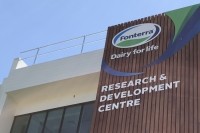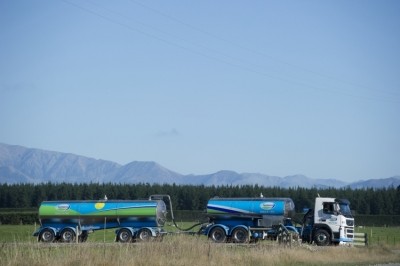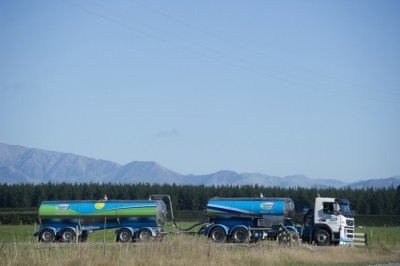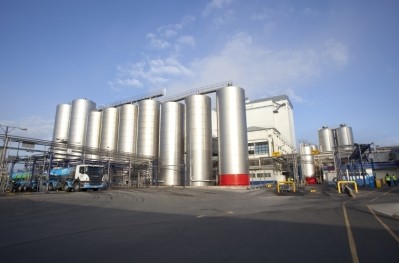Chile and Australian operations under review as Fonterra prioritizes NZ milk in long-term plan
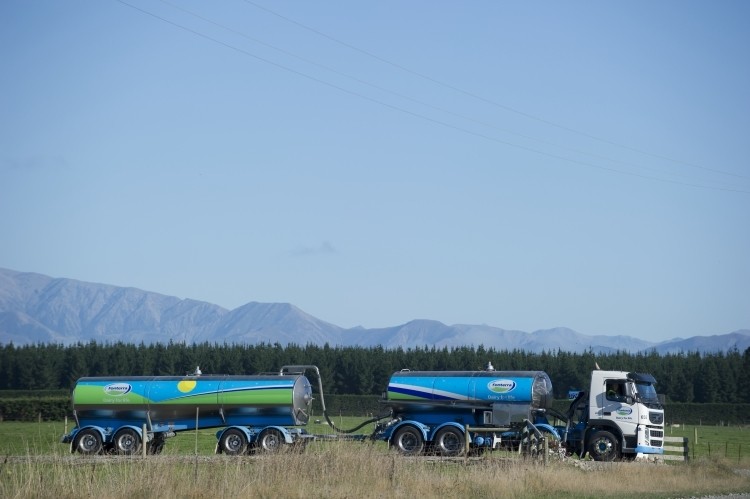
And this means a focus on New Zealand milk, which means it Chile and Australia operations are under scrutiny.
The numbers
Total group normalized EBIT was up 8% to NZ$952m (US$671m), with total group normalized operating expenditure down 3% to NZ$2.2bn (US$1.55bn).
CEO Miles Hurrell said net debt is down by NZ$872m (US$615m) to NZ$3.8bn (US$2.7m), cashflow has improved again and at 2.7x, the cooperative is now within its long-term target debt/EBITDA ratio.
“We are pleased with our NZ$599m (US$422m) reported profit after tax,” Hurrell said.
“While down on last year, the 2020 financial year benefited significantly from the divestments of DFE Pharma and foodspring. Normalized profit after tax grew by NZ$190m (US$134m) to NZ$588m (US$415m), driven by improved earnings and lower interest expense.
“Our sales book is well balanced across the regions and a number of our markets have performed well. In Asia Pacific, significant improvements in our foodservice and consumer channels have pushed normalized EBIT up 28% to NZ$305m (US$215m). We’ve expanded our foodservice footprint in the region and are seeing the benefits of that.”
Hurrell said changing consumer behavior due to Covid-19, with people choosing to cook at home, has benefited consumer brands and supported upward momentum in the consumer channel performance, particularly in New Zealand and Australia.
“Greater China continues to be an important market for us, with normalized EBIT up 10% to NZ$403m (US$284m). This speaks to the strength of our Foodservice channel, China’s dynamic economy and its love for dairy.
“Africa, Middle East, Europe, North Asia, Americas’ (AMENA) normalized EBIT was down 28% to NZ$336m (US$237m), reflecting our strategy of redirecting product into higher-margin markets. However, we have seen improvements in our foodservice and consumer channels within the region, including a turnaround for our Chilean business.
“Our total dividend for the year is 20 cents per share, which includes an interim dividend of 5 cents per share and a final dividend of 15 cents per share. Three cents of the 15 cents per share reflects the reversal of previous impairment of our China Farms. For a 100% share backed farm, this means a total pay-out of NZ$7.74 (US$5.46) per kgMS.”
Looking to the current season, Fonterra announced a 2021/22 earnings guidance range of 25-40 cents per share and has also reaffirmed its 2021/22 forecast Farmgate Milk Price range of NZ$7.25 - NZ$8.75 (US$5.11 - US$6.17) per kgMS, with a midpoint of NZ$8 (US$5.64) per kgMS.
Hurrell said the last three years have been about resetting the business.
“We’ve stuck to our strategy of maximizing the value of our New Zealand milk, moved to a customer-led operating model and strengthened our balance sheet. The results and total pay-out we’ve announced today show what we can achieve when we focus on quality execution and an aligned coop.
“The work we’ve done as part of the 2019 strategic reset means we’re well placed to take advantage of favorable industry dynamics. Growing global demand for dairy coupled with constrained supply has resulted in high prices for our milk. Our resilient supply chain has allowed us to get products to market and the healthy demand for our farmers’ New Zealand milk has seen a record shipping year for the coop.
“We’ve continued to reshape our business and the sales of our joint venture farms and wholly-owned farming hubs in China. Our continued focus is to get our New Zealand milk to the world.”
Long-term strategy
Fonterra said it is now turning the next phase of its strategy, as it completes its reset and focuses on value growth.
Hurrell said the cooperative has made three strategic choices: “Continue to focus on New Zealand milk, be a leader in sustainability and be a leader in dairy innovation and science.”
New Zealand approach means changes in Chile and Australia
Fonterra said it believes it has an opportunity to differentiate New Zealand milk further on the world stage, with the aim of getting more value from the coop’s milk.
Hurrell said this requires Fonterra to focus its capital and people on New Zealand milk and it has reviewed the ownership of its two other milk pools – in Australia and Chile.
“Soprole is a leading Chilean dairy brand, and Prolesur is a subsidiary of Soprole focused on sourcing milk and manufacturing products in Southern Chile. The operations do not require any New Zealand-sourced milk or expertise, and in this context, we are starting the process to divest our integrated investment in Chile.
“Fonterra Australia is on strategy for the coop and remains an important export market for our New Zealand milk, especially for Foodservice products and advanced ingredients. We are considering the most appropriate ownership structure for this business, one option is an IPO, with the intention that we retain a significant stake.
“We see both these moves as critical to enabling greater focus on our New Zealand milk and, importantly, allowing us to free up capital, much of which is intended to be returned to shareholders.”
Ingredients implications
Hurrell said to strengthen the value proposition of its New Zealand milk, Fonterra will increase investment in sustainability and R&D.
“Over the next decade we intend to invest around NZ$1bn (US$710m) in reducing carbon emissions and improving water efficiency and treatment at our manufacturing sites.
“We also know that to maintain our relative carbon footprint advantage against the northern hemisphere farming system we must solve the methane challenge.
“We are aiming to increase our current total annual R&D investment by over 50% to around NZ$160m (US$113m) per annum in 2030, with about NZ$60m (US$42m) per annum specifically targeted at growth in Active Living, as we continue to look for solutions for the methane challenge and develop new innovative products to support our value growth plans.
“Our investment in sustainability initiatives across our supply chain, will support our investment in our brands to showcase our New Zealand sustainable nutrition story. This will put us in a position to further grow our foodservice and consumer channels across our markets in the Asia Pacific region and gain more value through our Ingredients channel by helping customers meet their own sustainability goals.
“As we move more milk into foodservice and consumer, we will direct less through our Ingredients channel and aim to shift more towards higher value ingredients such as in our Active Living business. This will see us focus more of our Ingredients business on solutions for physical, patient, digestive and mental wellness plus immunity where we can make the most of our expertise in dairy innovation.”
Hurrell said focusing on value creation also opens up choices for investing in new, high value growth opportunities in future.
“We have an ambition to play more boldly in nutrition science solutions. We have set up a dedicated team to explore what the future of Nutrition Science Solutions looks likes for our coop, and over the next year we’ll narrow down and prioritise the areas where we can build a competitive advantage.”
2030 financial targets
The dairy cooperative said it has four key value targets by FY30: An average Farmgate Milk Price range for the decade of NZ$6.50-NZ$7.50 (US$4.58-US$5.29) per kgMS; a 40-50% increase in operating profit from FY21 and, with the reduced interest from having less debt, an approximately 75% increase in earnings to steadily increase dividends to around 40-45 cents per share by FY30; a group return on capital of 9-10%; and, through planned divestments and improved earnings, an intended return of about NZ$1bn to shareholders by FY24, and around NZ$2bn (US$1.41bn) of additional capital available for a mix of investment in further growth and return to shareholders. This is in addition to the approximately NZ$2bn expected to be invested in sustainability and moving milk into higher value products.
New flexible shareholding structure proposed as best option for farmers and coop
Fonterra’s board has also presented a revised capital structure proposal it will discuss with farmers over the coming weeks before deciding whether to proceed to a shareholder vote.
The “flexible shareholding” structure is a progression on the preferred option put forward at the start of the consultation process in May, but with key changes based on farmer feedback and further expert advice.
This includes a new minimum shareholding requirement set at 33% of milk supply (around 1 share per 3 kgMS), compared to the current compulsory requirement of 1 share per 1 kgMS. This is intended to strike a balance between providing a meaningful level of flexibility for those who need it, which is critical to maintaining a sustainable milk supply, while ensuring all farmers having some capital-backed supply.
It also features a new maximum shareholding requirement set at 4x milk supply, compared to the current 2x milk supply. This is intended to strike a balance between supporting liquidity in the farmer-only market – by ensuring more capacity for farmers to buy shares from those who want to sell – while avoiding significant concentration of ownership.
It also includes the option for more types of farmers buying shares, including sharemilkers, contract milkers and farm lessors. This is intended to recognize their connection to Fonterra, provide a pathway for future farmer owners and increase the number of potential participants in the farmer-only market by around 4,000 to support liquidity.
Exit provisions would be extended and entry provisions would be eased. Existing shareholders would have up to 15 seasons initially to exit, reducing annually to 10 seasons, which would also support liquidity and give these farmers greater choice about how long they retain an investment in the cooperative. Any new entrants would have up to six seasons to achieve the 33% minimum shareholding requirement. This compares to a standard three seasons for both entry and exit under the current structure.
The Fonterra Shareholders’ Fund would be capped to protect farmer ownership and control. If greater flexibility was provided without making any other changes to the current structure, the thresholds relating to the size of the fund could be exceeded relatively quickly, because farmers would be able to hold fewer shares and non-farmers would be able to invest more through the fund.
The Fonterra Shareholders’ Market (FSM) would continue to operate as a farmer-only market, but shares would no longer be able to be exchanged into units in the fund. As communicated in May, this means the share price may trade at a discount to the unit price, referred to as a restricted market discount. But aside from this initial adjustment, the farmer-only market should enable the cooperative’s share price to better reflect the higher costs of capital many farmers have compared to external investors with more diversified investment portfolios.
Additional measures to support liquidity in the farmer-only market would be implemented, recognizing there may be lower levels of trading, so the share price could move more on small volumes. The cooperative said it has sourced advice to determine the measures it would take to support liquidity. This includes allocating up to NZ$300m (US$211.5m) to support liquidity as farmers transition to the proposed structure, through an on-market share buy-back program and other tools.
Fonterra chairman Peter McBride said changing the capital structure is a critical decision and not something the board and senior management are taking lightly.
“We are confident that this proposal would support the sustainable supply of New Zealand milk that our long-term strategy relies on. One enables the other, and together they give our Co-operative the potential to deliver the competitive returns that will continue to support our families’ livelihoods from this generation to the next,” McBride said.
“Our future success relies on our ability to maintain a sustainable milk supply in an increasingly competitive environment, and one that is rapidly changing due to factors such as environmental pressures, new regulations and alternative land uses.
“We see total New Zealand milk supply as likely to decline, and flat at best. Our share of that decline depends on the actions we take with our capital structure, performance, productivity and sustainability. If we do nothing, we are likely to see around 12-20% decline by 2030 based on the scenarios we have modeled.
“Farmers leave the cooperative for different reasons, but one of the most influential ones is the high level of compulsory investment that’s required to be part of our cooperative. A capital structure with Flexible Shareholding would help to level the playing field with competitors, many of whom are foreign-backed and don’t require farmers to invest capital.”
Under the Flexible Shareholding structure, farmer ownership and control would be protected by capping the fund. This means shares in the farmer-only FSM would no longer be able to be exchanged into units.
The proposed changes would also protect against the uncertain and recurring risk to the cooperative’s balance sheet that would come with having to buy back shares or units to stay within thresholds related to the Fund size if milk supply declined under the current structure. Those thresholds exist to protect farmers’ ownership and control of Fonterra.
The cooperative said it is still aiming for a farmer vote at its annual meeting in December.
Before a vote could take place, at least 50% of Fonterra Co-operative Council members would need to support the final proposed changes. Ahead of a vote, voting documents would provide farmers with everything they need to know to assess the proposed changes they would be voting on. The approval of 75% of votes from voting farmers would then be required.
As some aspects of Fonterra’s current capital structure are reflected in the Dairy Industry Restructuring Act 2001 (DIRA), any vote would be conditional on the necessary changes to legislation being passed.
